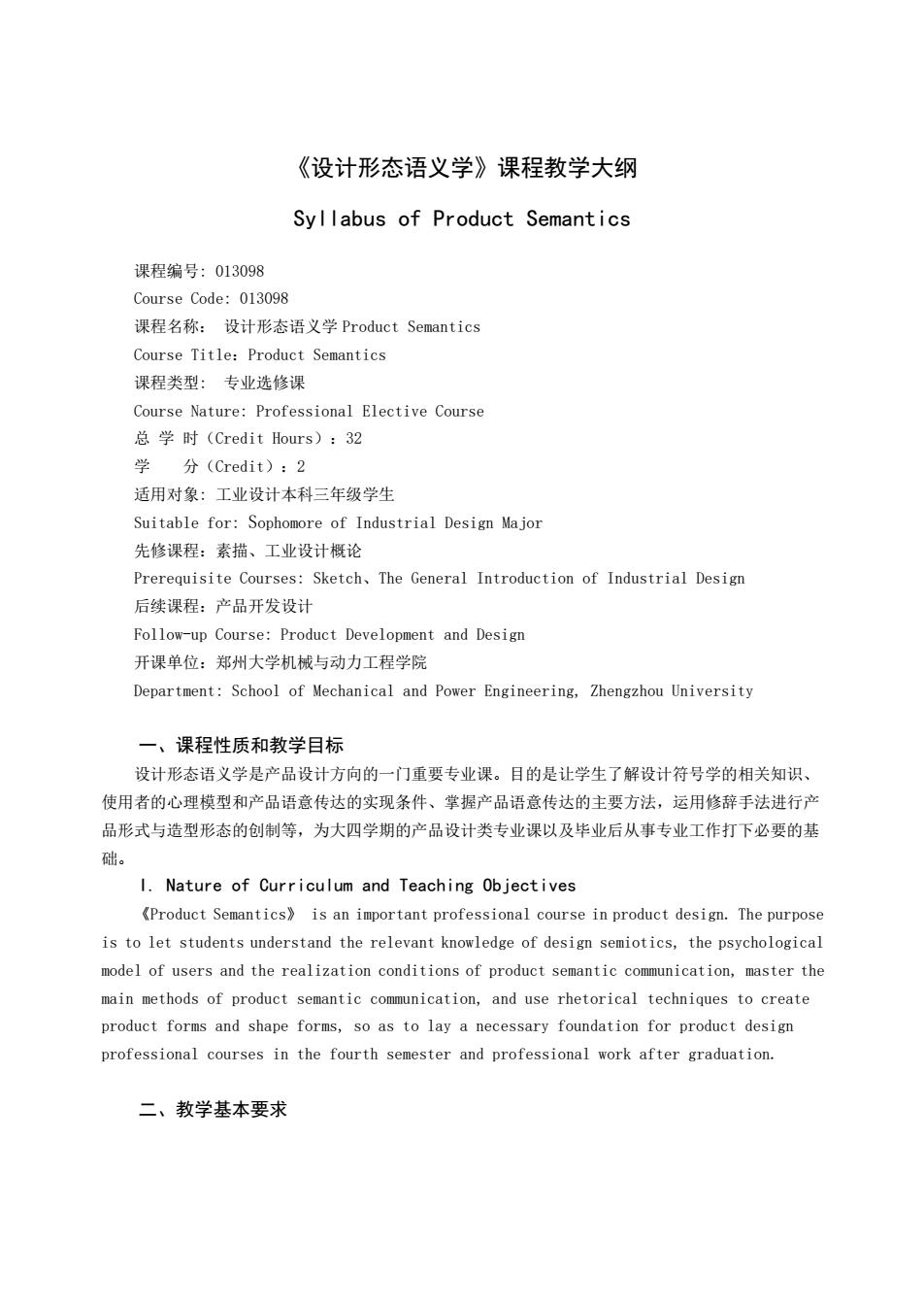
《设计形态语义学》课程教学大纲 Syllabus of Product Semantics 课程编号:013098 Course Code:013098 课程名称:设计形态语义学Product Semantics Course Title:Product Semantics 课程类型:专业选修课 Course Nature:Professional Elective Course 总学时(Credit Hours):32 学分(Credit):2 适用对象:工业设计本科三年级学生 Suitable for:Sophomore of Industrial Design Major 先修课程:素描、工业设计概论 Prerequisite Courses:Sketch,The General Introduction of Industrial Design 后续课程:产品开发设计 Follow-up Course:Product Development and Design 开课单位:郑州大学机械与动力工程学院 Department:School of Mechanical and Power Engineering,Zhengzhou University 一、课程性质和教学目标 设计形态语义学是产品设计方向的一门重要专业课。目的是让学生了解设计符号学的相关知识、 使用者的心理模型和产品语意传达的实现条件、掌握产品语意传达的主要方法,运用修辞手法进行产 品形式与造型形态的创制等,为大四学期的产品设计类专业课以及毕业后从事专业工作打下必要的基 础。 1.Nature of Curriculum and Teaching Objectives (Product Semantics)is an important professional course in product design.The purpose is to let students understand the relevant knowledge of design semiotics,the psychological model of users and the realization conditions of product semantic comunication,master the main methods of product semantic communication,and use rhetorical techniques to create product forms and shape forms,so as to lay a necessary foundation for product design professional courses in the fourth semester and professional work after graduation. 二、教学基本要求
《设计形态语义学》课程教学大纲 Syllabus of Product Semantics 课程编号: 013098 Course Code: 013098 课程名称: 设计形态语义学 Product Semantics Course Title:Product Semantics 课程类型: 专业选修课 Course Nature: Professional Elective Course 总 学 时(Credit Hours):32 学 分(Credit):2 适用对象: 工业设计本科三年级学生 Suitable for: Sophomore of Industrial Design Major 先修课程:素描、工业设计概论 Prerequisite Courses: Sketch、The General Introduction of Industrial Design 后续课程:产品开发设计 Follow-up Course: Product Development and Design 开课单位:郑州大学机械与动力工程学院 Department: School of Mechanical and Power Engineering, Zhengzhou University 一、课程性质和教学目标 设计形态语义学是产品设计方向的一门重要专业课。目的是让学生了解设计符号学的相关知识、 使用者的心理模型和产品语意传达的实现条件、掌握产品语意传达的主要方法,运用修辞手法进行产 品形式与造型形态的创制等,为大四学期的产品设计类专业课以及毕业后从事专业工作打下必要的基 础。 I. Nature of Curriculum and Teaching Objectives 《Product Semantics》 is an important professional course in product design. The purpose is to let students understand the relevant knowledge of design semiotics, the psychological model of users and the realization conditions of product semantic communication, master the main methods of product semantic communication, and use rhetorical techniques to create product forms and shape forms, so as to lay a necessary foundation for product design professional courses in the fourth semester and professional work after graduation. 二、教学基本要求
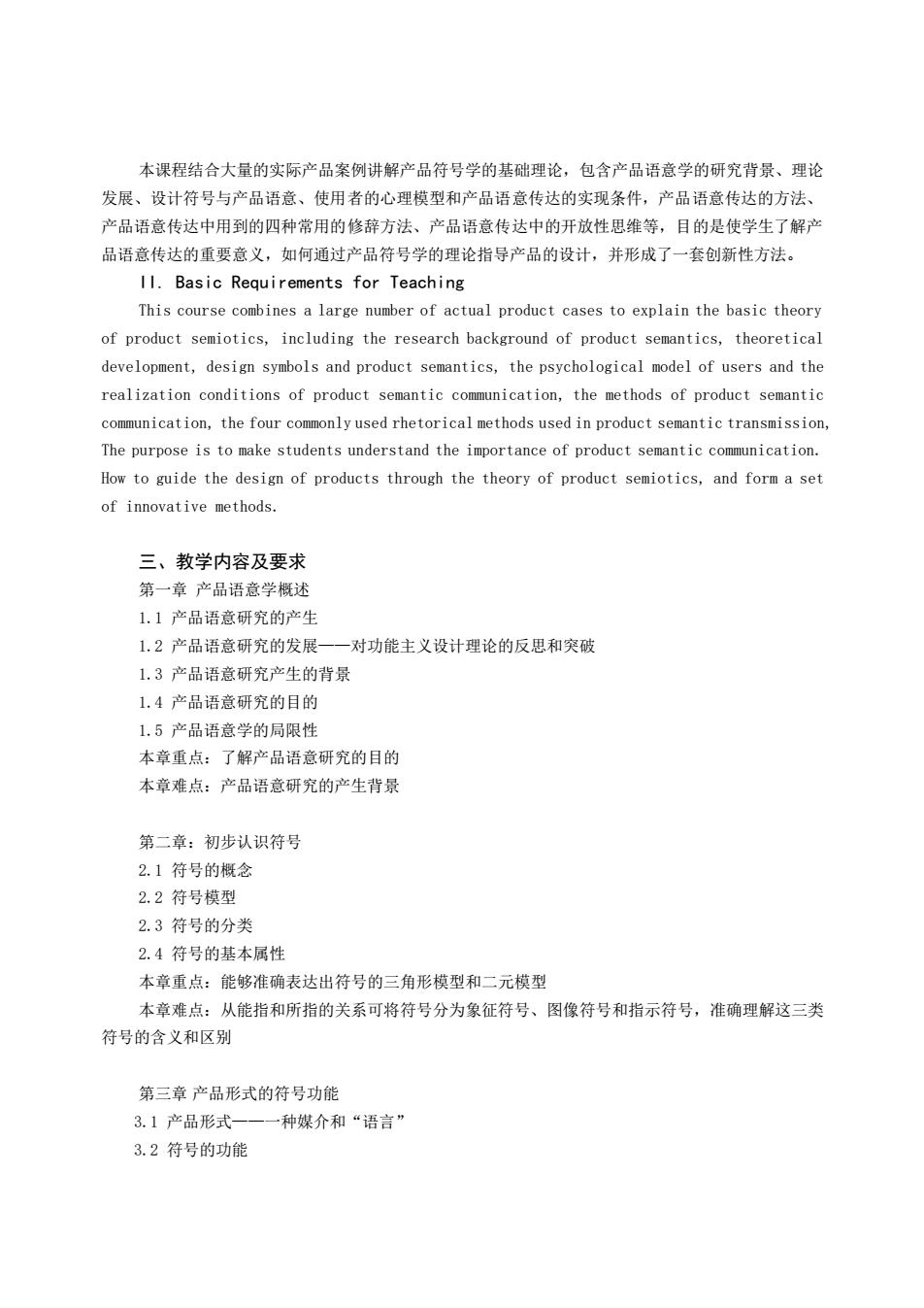
本课程结合大量的实际产品案例讲解产品符号学的基础理论,包含产品语意学的研究背景、理论 发展、设计符号与产品语意、使用者的心理模型和产品语意传达的实现条件,产品语意传达的方法、 产品语意传达中用到的四种常用的修辞方法、产品语意传达中的开放性思维等,目的是使学生了解产 品语意传达的重要意义,如何通过产品符号学的理论指导产品的设计,并形成了一套创新性方法。 11.Basic Requirements for Teaching This course combines a large number of actual product cases to explain the basic theory of product semiotics,including the research background of product semantics,theoretical development,design symbols and product semantics,the psychological model of users and the realization conditions of product semantic communication,the methods of product semantic communication,the four commonly used rhetorical methods used in product semantic transmission The purpose is to make students understand the importance of product semantic comunication. How to guide the design of products through the theory of product semiotics,and form a set of innovative methods 三、教学内容及要求 第一意产品语意学概术 1.1产品语意研究的产生 1.2产品语意研究的发展 一对功能主义设计理论的反思和突破 13产品语意研究产生的背景 1.4产品语意研究的日的 1.5产品语意学的局限性 本章重点:了解产品语意研究的目的 本章难点:产品语意研究的产生背景 第二章:初步认识符号 2.1符号的概今 2.2符号模型 2.3符号的分类 2.4符号的基本属性 本章重点:能够准确表达出符号的三角形模型和二元模型 本章难点:从能指和所指的关系可将符号分为象征符号、图像符号和指示符号,准确理解这三类 符号的含义和区别 第三章产品形式的符号功能 3.1产品形式一 一种媒介和“语言” 3.2符号的功能
本课程结合大量的实际产品案例讲解产品符号学的基础理论,包含产品语意学的研究背景、理论 发展、设计符号与产品语意、使用者的心理模型和产品语意传达的实现条件,产品语意传达的方法、 产品语意传达中用到的四种常用的修辞方法、产品语意传达中的开放性思维等,目的是使学生了解产 品语意传达的重要意义,如何通过产品符号学的理论指导产品的设计,并形成了一套创新性方法。 II. Basic Requirements for Teaching This course combines a large number of actual product cases to explain the basic theory of product semiotics, including the research background of product semantics, theoretical development, design symbols and product semantics, the psychological model of users and the realization conditions of product semantic communication, the methods of product semantic communication, the four commonly used rhetorical methods used in product semantic transmission, The purpose is to make students understand the importance of product semantic communication. How to guide the design of products through the theory of product semiotics, and form a set of innovative methods. 三、教学内容及要求 第一章 产品语意学概述 1.1 产品语意研究的产生 1.2 产品语意研究的发展——对功能主义设计理论的反思和突破 1.3 产品语意研究产生的背景 1.4 产品语意研究的目的 1.5 产品语意学的局限性 本章重点:了解产品语意研究的目的 本章难点:产品语意研究的产生背景 第二章:初步认识符号 2.1 符号的概念 2.2 符号模型 2.3 符号的分类 2.4 符号的基本属性 本章重点:能够准确表达出符号的三角形模型和二元模型 本章难点:从能指和所指的关系可将符号分为象征符号、图像符号和指示符号,准确理解这三类 符号的含义和区别 第三章 产品形式的符号功能 3.1 产品形式——一种媒介和“语言” 3.2 符号的功能
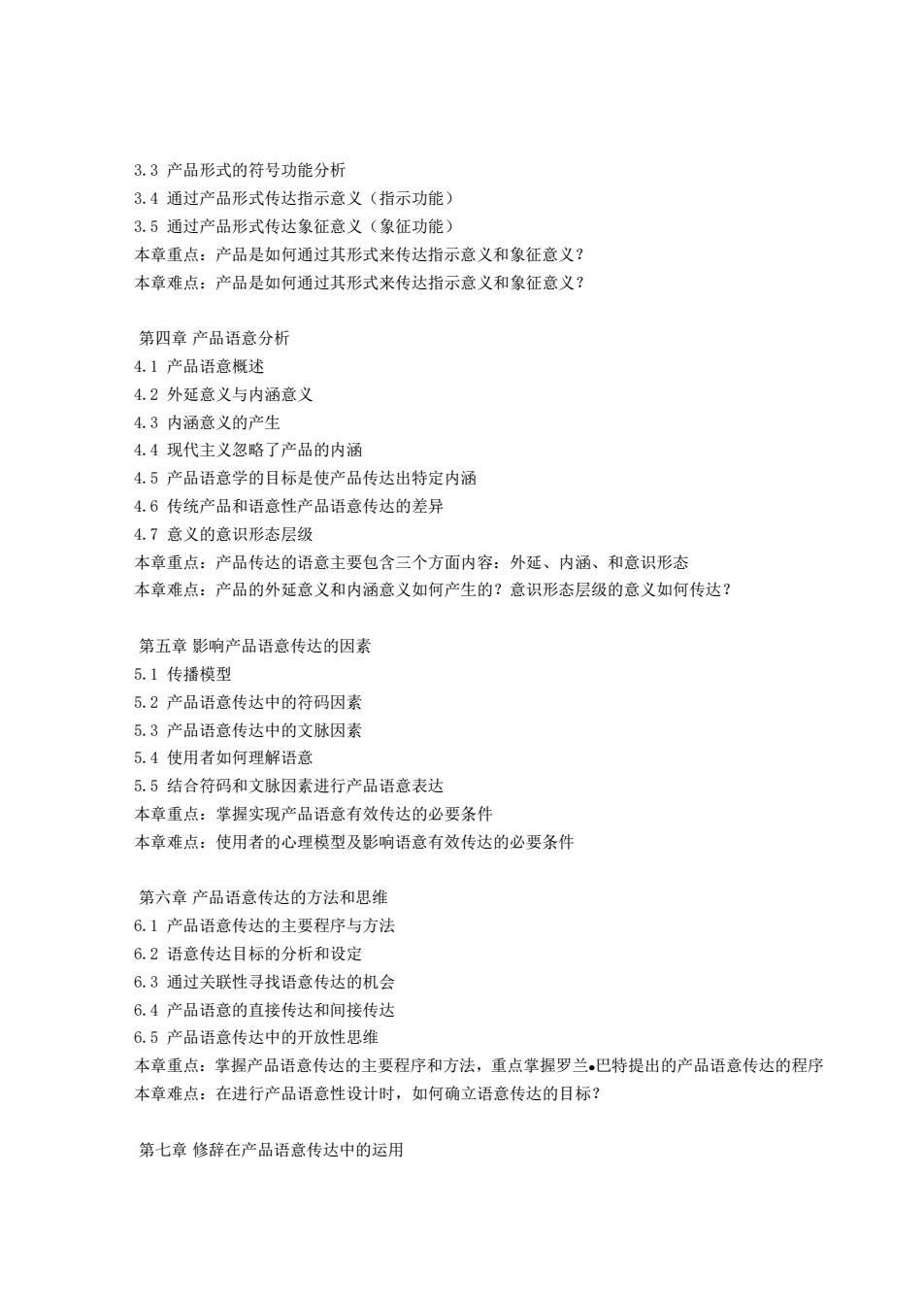
3.3产品形式的符号功能分析 3.4通过产品形式传达指示意义(指示功能) 3.5通过产品形式传达象征意义(象征功能) 本章重点:产品是如何通过其形式来传达指示意义和象征意义? 本章难点:产品是如何通过其形式来传达指示意义和象征意义? 第四章产品语意分析 4.1产品语意韬述 4.2外延意义与内涵意义 43内活意义的产牛 4.4现代主义忽略了产品的内涵 4.5产品语意学的目标是使产品传达出特定内涵 4.6传统产品和语意性产品语意传达的差异 4.7意义的意识形态层级 本章重点:产品传达的语意主要包含三个方面内容:外延、内涵、和意识形态 本章难点:产品的外延意义和内涵意义如何产生的?意识形态层级的意义如何传达? 第五章影响产品语意传达的因素 5.1传播模型 5.2产品语意传达中的符码因素 5.3产品语意传达中的文脉因素 5.4使用者如何理解语意 5.5结合符码和文脉因素进行产品语意表达 本章重点:掌握实现产品语意有效传达的必要条件 本章难点:使用者的心理模型及影响语意有效传达的必要条件 第六章产品语意传达的方法和思维 6.1产品语意传达的主要程序与方法 6.2语意传达目标的分析和设定 6.3通过关联性寻找语意传达的机会 6.4产品语意的直接传达和间接传达 6.5产品语意传达中的开放性思维 本章重点:掌握产品语意传达的主要程序和方法,重点掌握罗兰巴特提出的产品语意传达的程序 本章难点:在进行产品语意性设计时,如何确立语意传达的目标? 第七章修辞在产品语意传达中的运用
3.3 产品形式的符号功能分析 3.4 通过产品形式传达指示意义(指示功能) 3.5 通过产品形式传达象征意义(象征功能) 本章重点:产品是如何通过其形式来传达指示意义和象征意义? 本章难点:产品是如何通过其形式来传达指示意义和象征意义? 第四章 产品语意分析 4.1 产品语意概述 4.2 外延意义与内涵意义 4.3 内涵意义的产生 4.4 现代主义忽略了产品的内涵 4.5 产品语意学的目标是使产品传达出特定内涵 4.6 传统产品和语意性产品语意传达的差异 4.7 意义的意识形态层级 本章重点:产品传达的语意主要包含三个方面内容:外延、内涵、和意识形态 本章难点:产品的外延意义和内涵意义如何产生的?意识形态层级的意义如何传达? 第五章 影响产品语意传达的因素 5.1 传播模型 5.2 产品语意传达中的符码因素 5.3 产品语意传达中的文脉因素 5.4 使用者如何理解语意 5.5 结合符码和文脉因素进行产品语意表达 本章重点:掌握实现产品语意有效传达的必要条件 本章难点:使用者的心理模型及影响语意有效传达的必要条件 第六章 产品语意传达的方法和思维 6.1 产品语意传达的主要程序与方法 6.2 语意传达目标的分析和设定 6.3 通过关联性寻找语意传达的机会 6.4 产品语意的直接传达和间接传达 6.5 产品语意传达中的开放性思维 本章重点:掌握产品语意传达的主要程序和方法,重点掌握罗兰●巴特提出的产品语意传达的程序 本章难点:在进行产品语意性设计时,如何确立语意传达的目标? 第七章 修辞在产品语意传达中的运用
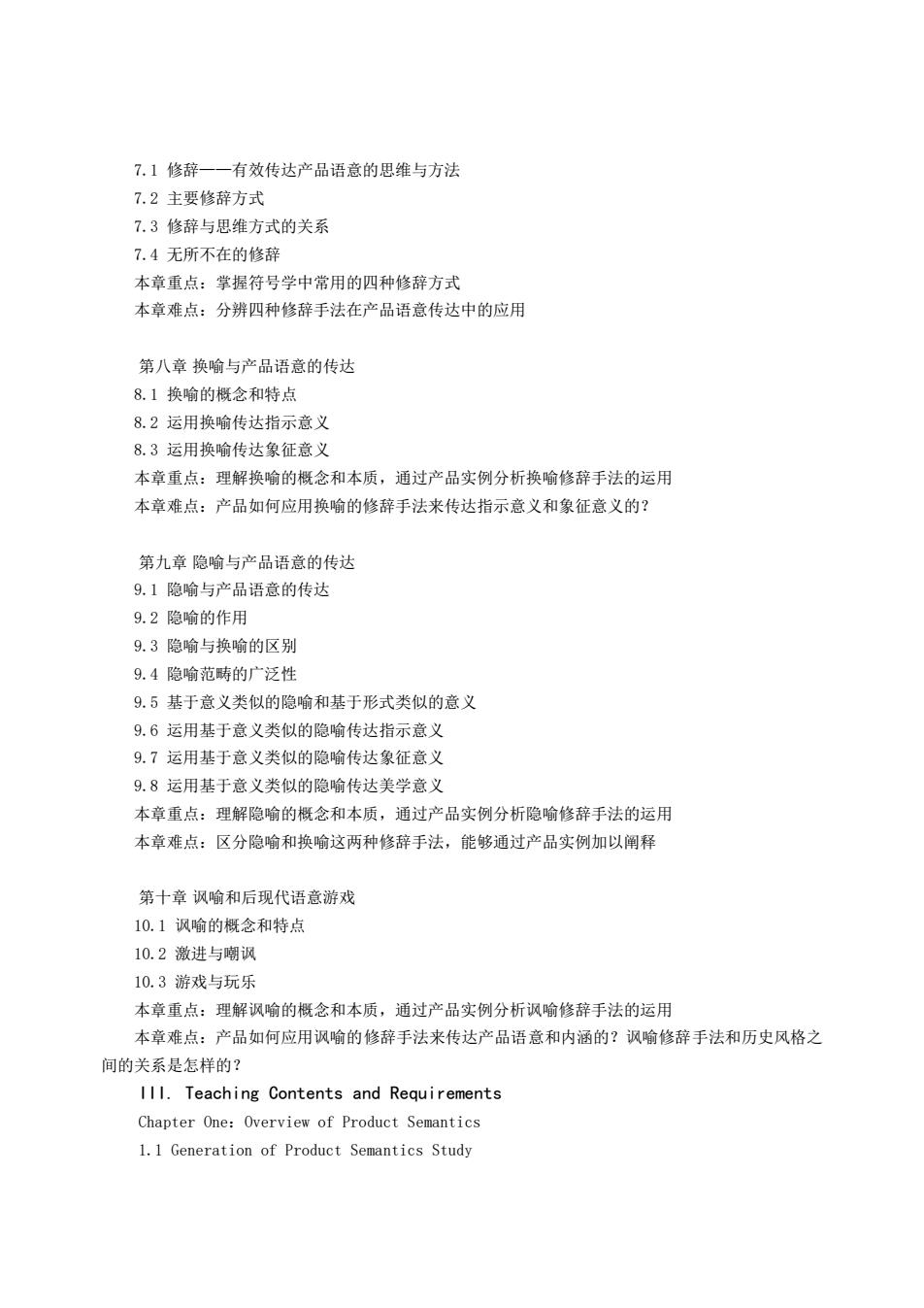
7.1修辞一一有效传达产品语意的思维与方法 7.2主要修辞方式 7.3修辞与思维方式的关系 7.4无所不在的修辞 本章重点:掌握符号学中常用的四种修辞方式 本章难点:分辨四种修辞手法在产品语意传达中的应用 第八章换喻与产品语意的传达 8.1换喻的概念和特点 8.2运用换喻传达指示意义 8.3运用换喻传达象征意义 本章重点:理解换喻的概念和本质,通过产品实例分析换喻修辞手法的运用 本章难点:产品如何应用换喻的修辞手法来传达指示意义和象征意义的? 第九章隐喻与产品语意的传达 9.1隐喻与产品语意的传达 9.2隐喻的作用 9.3隐喻与换喻的区别 9.4隐喻范畴的广泛性 9.5基于意义类似的隐喻和基于形式类似的意义 9.6运用基于意义类似的隐喻传达指示意义 9.7运用基于意义类似的隐喻传达象征意义 9.8运用基于意义类似的隐喻传达美学意义 本章重点:理解隐喻的概念和本质,通过产品实例分析隐喻修辞手法的运用 本章难点:区分隐喻和换喻这两种修辞手法,能够通过产品实例加以阐释 第十章讽喻和后现代语意游戏 10.1讽喻的概念和特点 10.2激进与啊讽 10.3游戏与玩乐 本章重点:理解讽喻的概念和本质,通过产品实例分析讽喻修辞手法的运用 本章难点:产品如何应用讽喻的修辞手法来传达产品语意和内涵的?讽喻修辞手法和历史风格之 间的关系是怎样的? 111.Teaching Contents and Requirements Chapter One:Overview of Product Semantics 1.1 Generation of Product Semantics Study
7.1 修辞——有效传达产品语意的思维与方法 7.2 主要修辞方式 7.3 修辞与思维方式的关系 7.4 无所不在的修辞 本章重点:掌握符号学中常用的四种修辞方式 本章难点:分辨四种修辞手法在产品语意传达中的应用 第八章 换喻与产品语意的传达 8.1 换喻的概念和特点 8.2 运用换喻传达指示意义 8.3 运用换喻传达象征意义 本章重点:理解换喻的概念和本质,通过产品实例分析换喻修辞手法的运用 本章难点:产品如何应用换喻的修辞手法来传达指示意义和象征意义的? 第九章 隐喻与产品语意的传达 9.1 隐喻与产品语意的传达 9.2 隐喻的作用 9.3 隐喻与换喻的区别 9.4 隐喻范畴的广泛性 9.5 基于意义类似的隐喻和基于形式类似的意义 9.6 运用基于意义类似的隐喻传达指示意义 9.7 运用基于意义类似的隐喻传达象征意义 9.8 运用基于意义类似的隐喻传达美学意义 本章重点:理解隐喻的概念和本质,通过产品实例分析隐喻修辞手法的运用 本章难点:区分隐喻和换喻这两种修辞手法,能够通过产品实例加以阐释 第十章 讽喻和后现代语意游戏 10.1 讽喻的概念和特点 10.2 激进与嘲讽 10.3 游戏与玩乐 本章重点:理解讽喻的概念和本质,通过产品实例分析讽喻修辞手法的运用 本章难点:产品如何应用讽喻的修辞手法来传达产品语意和内涵的?讽喻修辞手法和历史风格之 间的关系是怎样的? III. Teaching Contents and Requirements Chapter One:Overview of Product Semantics 1.1 Generation of Product Semantics Study
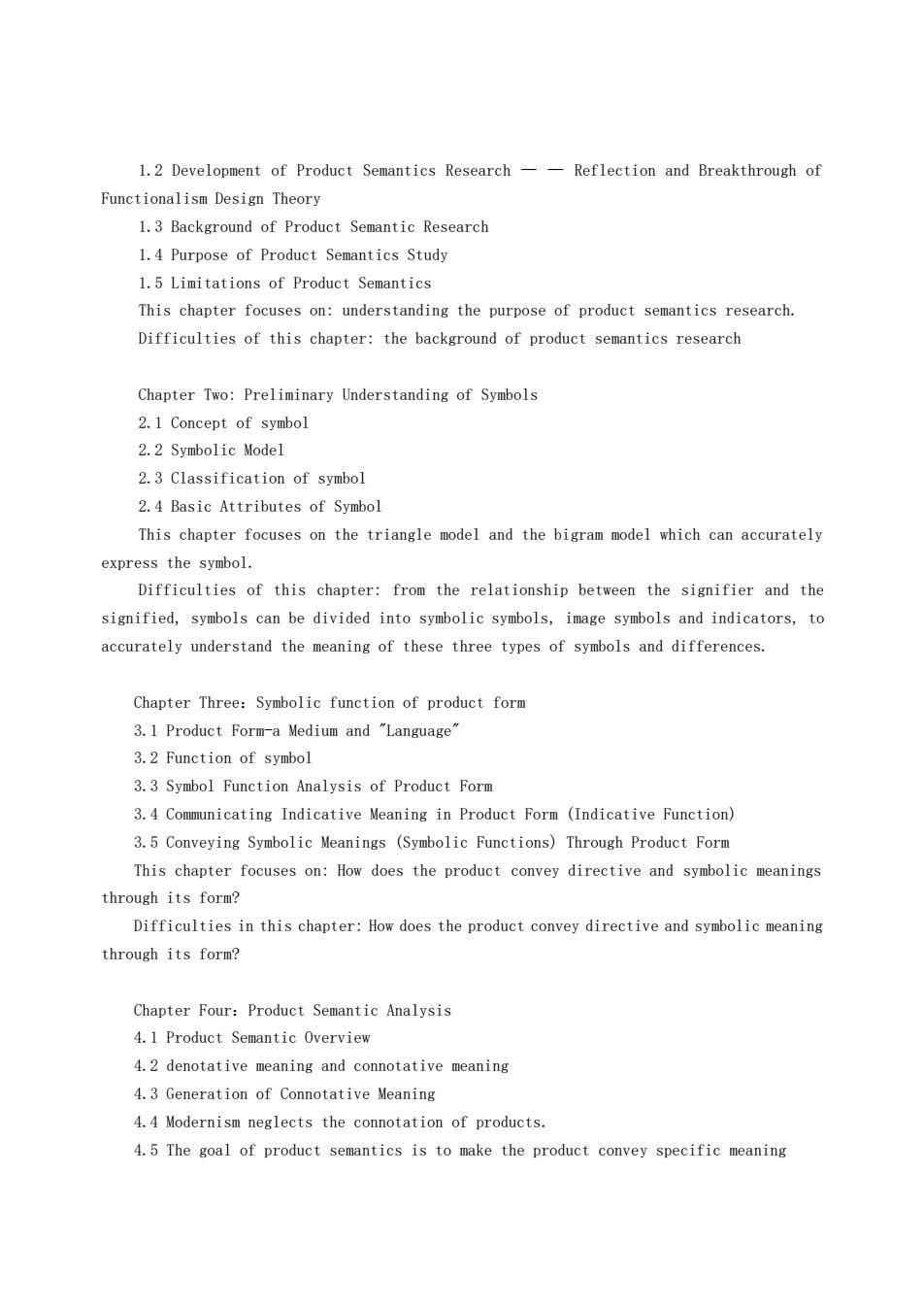
1.2 Development of Product Semantics Research--Reflection and Breakthrough of Functionalism Design Theory 1.3 Background of Product Semantic Research 1.4 Purpose of Product Semantics Study 1.5 Limitations of Product Semantics This chapter focuses on:understanding the purpose of product semantics research. Difficulties of this chapter:the background of product semantics research Chapter Two:Preliminary Understanding of Symbols 2.1 Concept of symbol 2.2 Symbolic Model 2.3 Classification of symbol 2.4 Basic Attributes of Symbo This chapter focuses on the triangle model and the bigram model which can accurately express the symbol. Difficulties of this chapter:from the relationship between the signifier and the signified,symbols can be divided into symbolic symbols,image symbols and indicators,to accurately understand the meaning of these three types of symbols and differences. Chapter Three:Symbolic function of product form 3.1 Product Form-a Medium and "Language 3.2 Function of symbol 3.3 Symbol Function Analysis of Product Form 3.4 Communicating Indicative Meaning in Product Form (Indicative Function) 3.5 Conveying Symbolic Meanings (Symbolic Functions)Through Product Form This chapter focuses on:How does the product convey directive and symbolic meanings through its form? Difficulties in this chapter:How does the product convey directive and symbolic meaning through its form? Chapter Four:Product Semantic Analysis 4.1 Product Semantic Overview 4.2 denotative meaning and connotative meaning 4.3 Generation of Connotative Meaning 4.4 Modernism neglects the connotation of products. 4.5 The goal of product semantics is to make the product convey specific meaning
1.2 Development of Product Semantics Research — — Reflection and Breakthrough of Functionalism Design Theory 1.3 Background of Product Semantic Research 1.4 Purpose of Product Semantics Study 1.5 Limitations of Product Semantics This chapter focuses on: understanding the purpose of product semantics research. Difficulties of this chapter: the background of product semantics research Chapter Two: Preliminary Understanding of Symbols 2.1 Concept of symbol 2.2 Symbolic Model 2.3 Classification of symbol 2.4 Basic Attributes of Symbol This chapter focuses on the triangle model and the bigram model which can accurately express the symbol. Difficulties of this chapter: from the relationship between the signifier and the signified, symbols can be divided into symbolic symbols, image symbols and indicators, to accurately understand the meaning of these three types of symbols and differences. Chapter Three:Symbolic function of product form 3.1 Product Form-a Medium and "Language" 3.2 Function of symbol 3.3 Symbol Function Analysis of Product Form 3.4 Communicating Indicative Meaning in Product Form (Indicative Function) 3.5 Conveying Symbolic Meanings (Symbolic Functions) Through Product Form This chapter focuses on: How does the product convey directive and symbolic meanings through its form? Difficulties in this chapter: How does the product convey directive and symbolic meaning through its form? Chapter Four:Product Semantic Analysis 4.1 Product Semantic Overview 4.2 denotative meaning and connotative meaning 4.3 Generation of Connotative Meaning 4.4 Modernism neglects the connotation of products. 4.5 The goal of product semantics is to make the product convey specific meaning

4.6 Differences of Semantic Communication between traditional products and semantic Product 4.7 Ideological Hierarchy of Meaning This chapter focuses on three aspects:denotation,connotation,and ideology Difficulties of this chapter:How does the denotative meaning and connotative meaning of the product come into being?How to convey the meaning of ideological hierarchy? Chapter Five:Factors Affecting Product Semantic Communication 5.1 Propagation Model 5.2 Symbol Factors in Product Semantic Communication 5.3 Context Factors in Product Semantic Communication 5.4 How the User Understands the Meaning 5.5 Product semantic expression combined with code and context factor The key point of this chapter is to grasp the necessary conditions for effective communication of product semantics. Difficulties in this chapter:the user's mental model and the necessary conditions for effective communication. Chapter Six:Methods and Thinking of Product Semantic Communication 6.1 Main Procedures and Methods for Product Semantic Communication 6.2 Analysis and Setting of Semantic Communication Goal 6.3 Finding opportunities to convey meaning through relevance 6.4 Direct and Indirect Communication of Product Semantic 6.5 Open Thinking in Product Semantic Communication This chapter focuses on:master the main procedures and methods of product semantic communication,focusing on the process of product semantic communication proposed by Roland Bart Difficulties in this chapter:how to establish the goal of semantic communication in the process of product semantic design? Chapter Seven:The Application of Rhetoric in Product Semantic Communication 7.1 Rhetoric--Thinking and Methods to Effectively Convey Product Meaning 7.2 Main Rhetorical Method 7.3 Relationship between Rhetoric and Mode of Thinking 7.4 Ubiquitous Rhetoric This chapter focuses on:to master the four commonly used in semiotics rhetoric
4.6 Differences of Semantic Communication between Traditional Products and Semantic Product 4.7 Ideological Hierarchy of Meaning This chapter focuses on three aspects: denotation, connotation, and ideology Difficulties of this chapter: How does the denotative meaning and connotative meaning of the product come into being? How to convey the meaning of ideological hierarchy? Chapter Five:Factors Affecting Product Semantic Communication 5.1 Propagation Model 5.2 Symbol Factors in Product Semantic Communication 5.3 Context Factors in Product Semantic Communication 5.4 How the User Understands the Meaning 5.5 Product semantic expression combined with code and context factor The key point of this chapter is to grasp the necessary conditions for effective communication of product semantics. Difficulties in this chapter: the user's mental model and the necessary conditions for effective communication. Chapter Six:Methods and Thinking of Product Semantic Communication 6.1 Main Procedures and Methods for Product Semantic Communication 6.2 Analysis and Setting of Semantic Communication Goal 6.3 Finding opportunities to convey meaning through relevance 6.4 Direct and Indirect Communication of Product Semantic 6.5 Open Thinking in Product Semantic Communication This chapter focuses on: master the main procedures and methods of product semantic communication, focusing on the process of product semantic communication proposed by Roland Bart Difficulties in this chapter: how to establish the goal of semantic communication in the process of product semantic design? Chapter Seven:The Application of Rhetoric in Product Semantic Communication 7.1 Rhetoric — — Thinking and Methods to Effectively Convey Product Meaning 7.2 Main Rhetorical Method 7.3 Relationship between Rhetoric and Mode of Thinking 7.4 Ubiquitous Rhetoric This chapter focuses on: to master the four commonly used in semiotics rhetoric
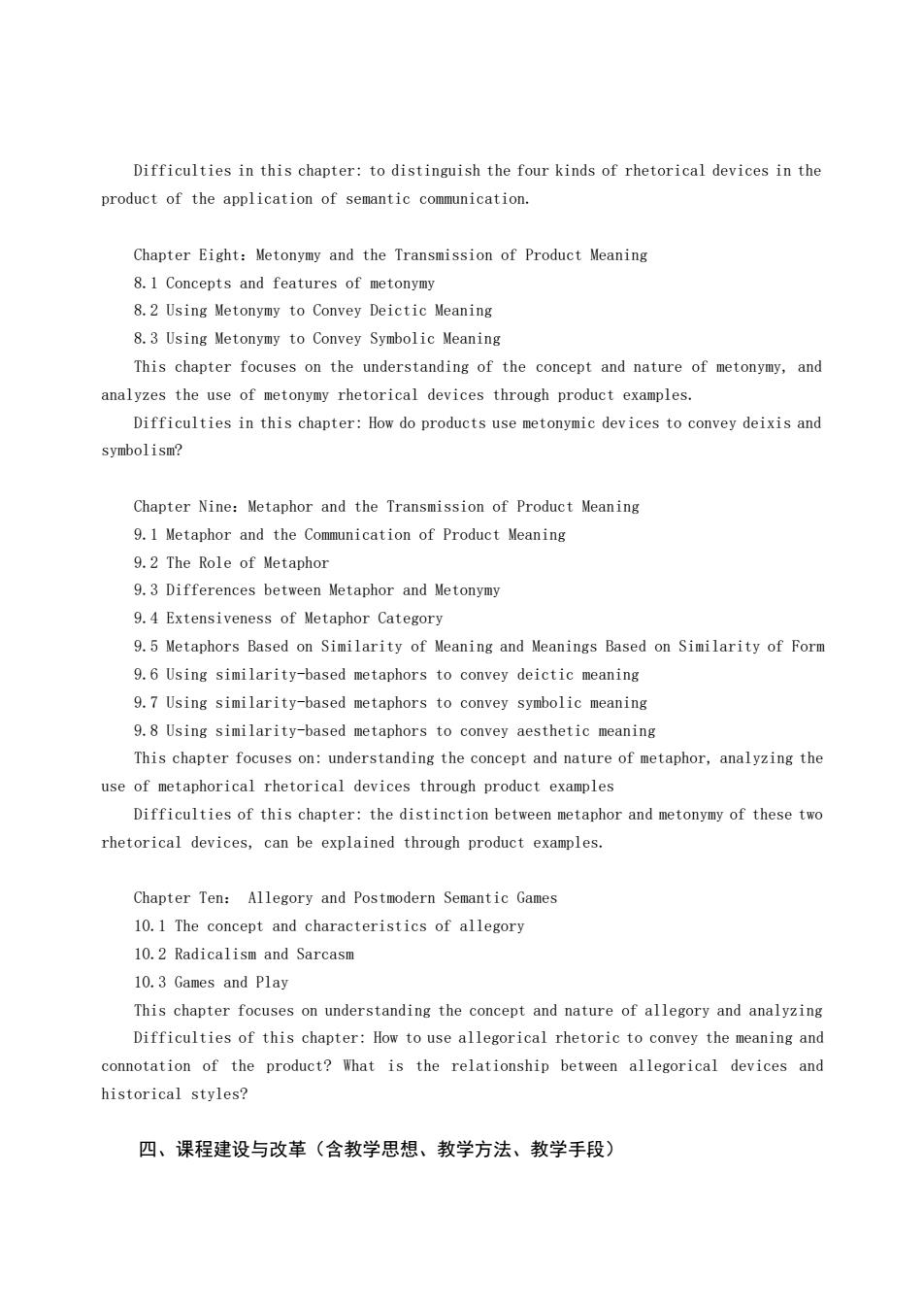
Difficulties in this chapter:to distinguish the four kinds of rhetorical devices in the product of the application of semantic communication. Chapter Eight:Metonymy and the Transmission of Product Meaning 8.1 Concepts and features of metonymy 8.2 Using Metonymy to Convey Deictic Meaning 8.3 Using Metonymy to Convey Symbolic Meaning This chapter focuses on the understanding of the concept and nature of metonymy,and analyzes the use of metonymy rhetorical devices through product examples. Difficulties in this chapter:How do products use metonymic devices to convey deixis and symbolism? Chapter Nine:Metaphor and the Transmission of Product Meaning 9.1 Metaphor and the Communication of Product Meaning 9.2 The Role of Metaphor 9.3 Differences between Metaphor and Metonymy 9.4 Extensiveness of Metaphor Category 9.5 Metaphors Based on Similarity of Meaning and Meanings Based on Similarity of Form 9.6 Using similarity-based metaphors to convey deictic meaning 9.7 Using similarity-based metaphors to convey symbolic meaning 9.8 Using similarity-based metaphors to convey aesthetic meaning This chapter focuses on:understanding the concept and nature of metaphor,analyzing the use of metaphorical rhetorical devices through product examples Difficulties of this chapter:the distinction between metaphor and metonymy of these two rhetorical devices,can be explained through product examples. Chapter Ten:Allegory and Postmodern Semantic Games 10.1 The concept and characteristics of allegory 10.2 Radicalism and Sarcasm 10.3 Games and Play This chapter focuses on understanding the concept and nature of allegory and analyzing Difficulties of this chapter:How to use allegorical rhetoric to convey the meaning and connotation of the product?What is the relationship between allegorical devices and historical styles? 四、课程建设与改革(含教学思想、教学方法、教学手段)
Difficulties in this chapter: to distinguish the four kinds of rhetorical devices in the product of the application of semantic communication. Chapter Eight:Metonymy and the Transmission of Product Meaning 8.1 Concepts and features of metonymy 8.2 Using Metonymy to Convey Deictic Meaning 8.3 Using Metonymy to Convey Symbolic Meaning This chapter focuses on the understanding of the concept and nature of metonymy, and analyzes the use of metonymy rhetorical devices through product examples. Difficulties in this chapter: How do products use metonymic devices to convey deixis and symbolism? Chapter Nine:Metaphor and the Transmission of Product Meaning 9.1 Metaphor and the Communication of Product Meaning 9.2 The Role of Metaphor 9.3 Differences between Metaphor and Metonymy 9.4 Extensiveness of Metaphor Category 9.5 Metaphors Based on Similarity of Meaning and Meanings Based on Similarity of Form 9.6 Using similarity-based metaphors to convey deictic meaning 9.7 Using similarity-based metaphors to convey symbolic meaning 9.8 Using similarity-based metaphors to convey aesthetic meaning This chapter focuses on: understanding the concept and nature of metaphor, analyzing the use of metaphorical rhetorical devices through product examples Difficulties of this chapter: the distinction between metaphor and metonymy of these two rhetorical devices, can be explained through product examples. Chapter Ten: Allegory and Postmodern Semantic Games 10.1 The concept and characteristics of allegory 10.2 Radicalism and Sarcasm 10.3 Games and Play This chapter focuses on understanding the concept and nature of allegory and analyzing Difficulties of this chapter: How to use allegorical rhetoric to convey the meaning and connotation of the product? What is the relationship between allegorical devices and historical styles? 四、课程建设与改革(含教学思想、教学方法、教学手段)
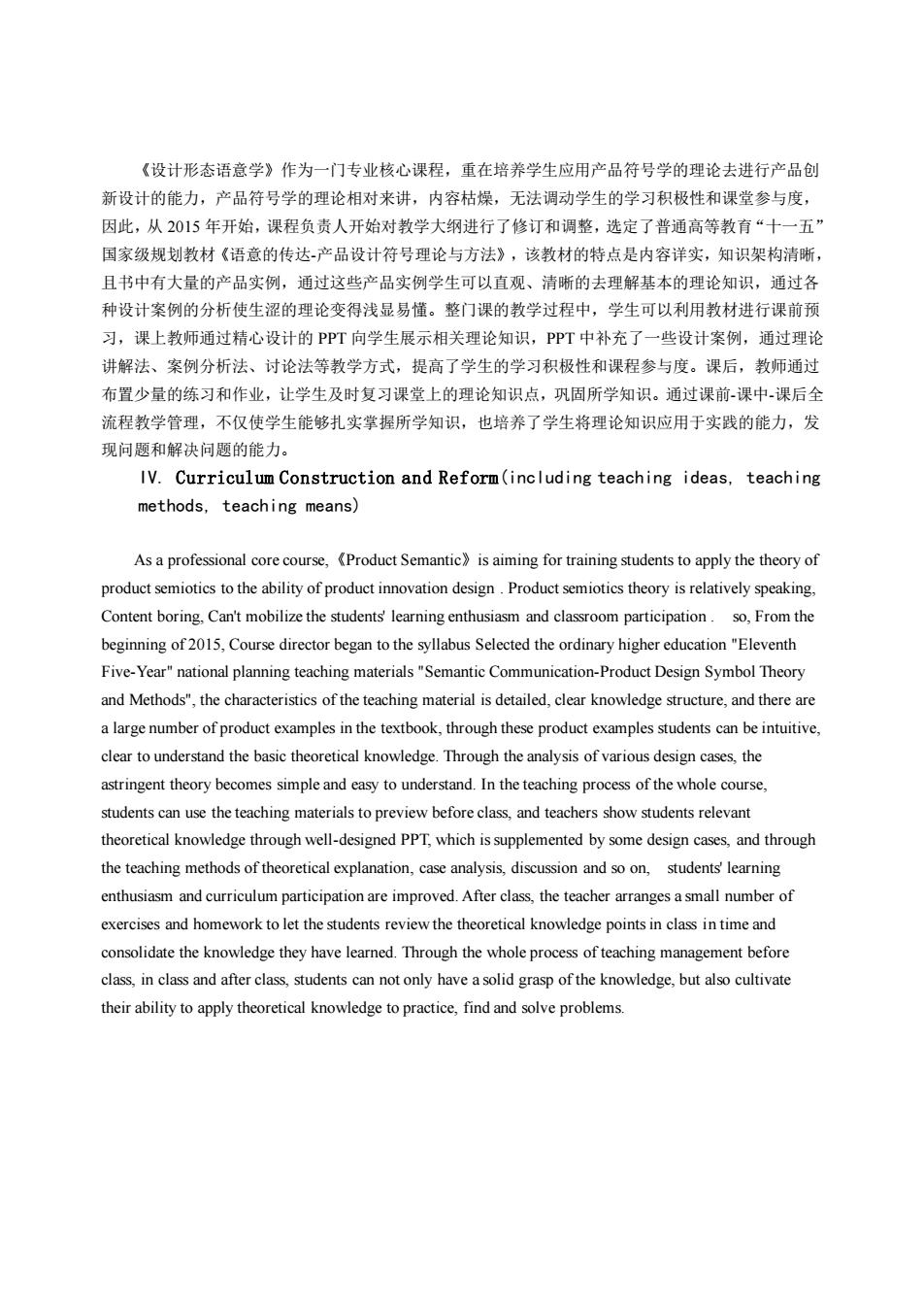
《设计形态语意学》作为一门专业核心课程,重在培养学生应用产品符号学的理论去进行产品创 新设计的能力,产品符号学的理论相对来讲,内容枯燥,无法调动学生的学习积极性和课堂参与度, 因此,从2015年开始,课程负责人开始对数学大纲讲行了锋订和调整,洗定了普通高等数有“十一五 国家级规划教材《语意的传达产品设计符号理论与方法》,该教材的特点是内容详实,知识架构清晰, 且书中有大量的产品实例,通过这些产品实例学生可以直观、清晰的去理解基本的理论知识,通过各 种设计案例的分析使生涩的理论变得浅显易懂。整门课的教学过程中,学生可以利用教材进行课前预 习,课上教师通过精心设计的PPT向学生展示相关理论知识,PPT中补充了一些设计案例,通过理论 讲解法、案例分析法、讨论法等教学方式,提高了学生的学习积极性和课程参与度。课后,教师通过 布置少量的练习和作业,让学生及时复习课堂上的理论知识点,巩固所学知识。通过课前课中课后全 流程教学管理,不仅使学生能够扎实掌握所学知识,也培养了学生将理论知识应用于实践的能力,发 现问题和解决问题的能力。 IV.Curriculum Construction and Reform(including teaching ideas.teaching methods,teaching means) Asa professional(Product for training students to apply the theory of product semiotics to the ability of product innovation design.Product semiotics theory is relatively speaking Content boring Can't mobilize the and participation. so,From the beginning of 2015.Course director began to the syllabus Selected the ordinary higher education"Eleventh Five-Year"national planning teaching materias"Communication-Product Design Symbol Theory and Methods",the characteristics of the teaching material is detailed,clear knowledge structure,and there are a of in the textbook through these product be intuitive clear to understand the basic theoretical knowledge.Through the analysis of various design cases,the astringent theory becomes simple and easy to understand.In the teaching process of the whole course. students can use the teaching materials to preview before class.and teachers show students relevant theoretical knowledge throug well-designed PPT.which is supplemented by om design and through the teaching methods of theoretical explanation.case analysis.discussion and so on.students'learning enthusiasm and curriculum participation are improved.After class,the teacher arrangesasmall number of exercises and homework to let the students review the theoretical knowledge points in class in time and consolidate the knowledge they have learmed.Through the whole process of teaching management before class.in class and after class.students can not only have a solid grasp of the knowledge.but also cultivate their ability to apply theoretical knowedge to practice,find and solve problems
《设计形态语意学》作为一门专业核心课程,重在培养学生应用产品符号学的理论去进行产品创 新设计的能力,产品符号学的理论相对来讲,内容枯燥,无法调动学生的学习积极性和课堂参与度, 因此,从 2015 年开始,课程负责人开始对教学大纲进行了修订和调整,选定了普通高等教育“十一五” 国家级规划教材《语意的传达-产品设计符号理论与方法》,该教材的特点是内容详实,知识架构清晰, 且书中有大量的产品实例,通过这些产品实例学生可以直观、清晰的去理解基本的理论知识,通过各 种设计案例的分析使生涩的理论变得浅显易懂。整门课的教学过程中,学生可以利用教材进行课前预 习,课上教师通过精心设计的 PPT 向学生展示相关理论知识,PPT 中补充了一些设计案例,通过理论 讲解法、案例分析法、讨论法等教学方式,提高了学生的学习积极性和课程参与度。课后,教师通过 布置少量的练习和作业,让学生及时复习课堂上的理论知识点,巩固所学知识。通过课前-课中-课后全 流程教学管理,不仅使学生能够扎实掌握所学知识,也培养了学生将理论知识应用于实践的能力,发 现问题和解决问题的能力。 IV. Curriculum Construction and Reform(including teaching ideas, teaching methods, teaching means) As a professional core course,《Product Semantic》is aiming for training students to apply the theory of product semiotics to the ability of product innovation design . Product semiotics theory is relatively speaking, Content boring, Can't mobilize the students' learning enthusiasm and classroom participation . so, From the beginning of 2015, Course director began to the syllabus Selected the ordinary higher education "Eleventh Five-Year" national planning teaching materials "Semantic Communication-Product Design Symbol Theory and Methods", the characteristics of the teaching material is detailed, clear knowledge structure, and there are a large number of product examples in the textbook, through these product examples students can be intuitive, clear to understand the basic theoretical knowledge. Through the analysis of various design cases, the astringent theory becomes simple and easy to understand. In the teaching process of the whole course, students can use the teaching materials to preview before class, and teachers show students relevant theoretical knowledge through well-designed PPT, which is supplemented by some design cases, and through the teaching methods of theoretical explanation, case analysis, discussion and so on, students' learning enthusiasm and curriculum participation are improved. After class, the teacher arranges a small number of exercises and homework to let the students review the theoretical knowledge points in class in time and consolidate the knowledge they have learned. Through the whole process of teaching management before class, in class and after class, students can not only have a solid grasp of the knowledge, but also cultivate their ability to apply theoretical knowledge to practice, find and solve problems

五、各教学环节学时分配(V.Credit Hours Allocation) 习题课讨论课 讲课 其他 Exerci Discus 实验 合计 ectur xperi-ment other Total e on 第一章产品语意学概述 Chapter 1 Overview of Produc 4 Senantics 第二章初步认识符号 Chapter Two:Preliminary 2 2 Inderstanding of Symbols 第三章产品形式的符号功能 Chapter Three Symbolic functio 4 4 of product form 第四章产品语意分析 chapter Four:Product Semantic 2 1 nalysis 第五章影响产品语意传达的因素 Chapter Five:Factors Affectin 2 Product Semantic Communication 第六章产品语意传达的方法和思细 Chapter Six:Methods and Thinking o 9 roduct Semantic Communication 第七章修辞在产品语意传达中的运月 hapter seven:The application of Rhetoric in Product Semantic 2 第八章换喻与产品语意的传达 hapter eight:Metonymy and the ransmission of Product Meaning 第九章隐喻与产品语意的传达 Chapter Nine Metaphor and the 4 ransmission of Product Meaning 第十章讽喻和后现代语意游戏 hapter Ten Allegory and 2 2 ostmodern Semantic Games 合计 30 32
五、各教学环节学时分配 (V. Credit Hours Allocation) 讲课 Lecture 习题课 Exercis e 讨论课 Discussi on 实验 Experi-ment 其他 other 合计 Total 第一章 产品语意学概述 Chapter 1 Overview of Product Senantics 4 4 第二章 初步认识符号 Chapter Two: Preliminary Understanding of Symbols 2 2 第三章 产品形式的符号功能 Chapter Three :Symbolic function of product form 4 4 第四章 产品语意分析 Chapter Four : Product Semantic Analysis 2 1 3 第五章 影响产品语意传达的因素 Chapter Five : Factors Affecting Product Semantic Communication 2 2 第六章 产品语意传达的方法和思维 Chapter Six:Methods and Thinking of Product Semantic Communication 4 1 5 第七章 修辞在产品语意传达中的运用 Chapter Seven:The Application of Rhetoric in Product Semantic Communication 2 2 第八章 换喻与产品语意的传达 Chapter Eight : Metonymy and the Transmission of Product Meaning 第八章 换喻与产品语意的传达 4 4 第九章 隐 喻 与 产 品 语 意 的 传 达 Chapter Nine : Metaphor and the Transmission of Product Meaning 4 4 第十章 讽喻和后现代语意游戏 Chapter Ten : Allegory and Postmodern Semantic Games 2 2 合计 30 2 32
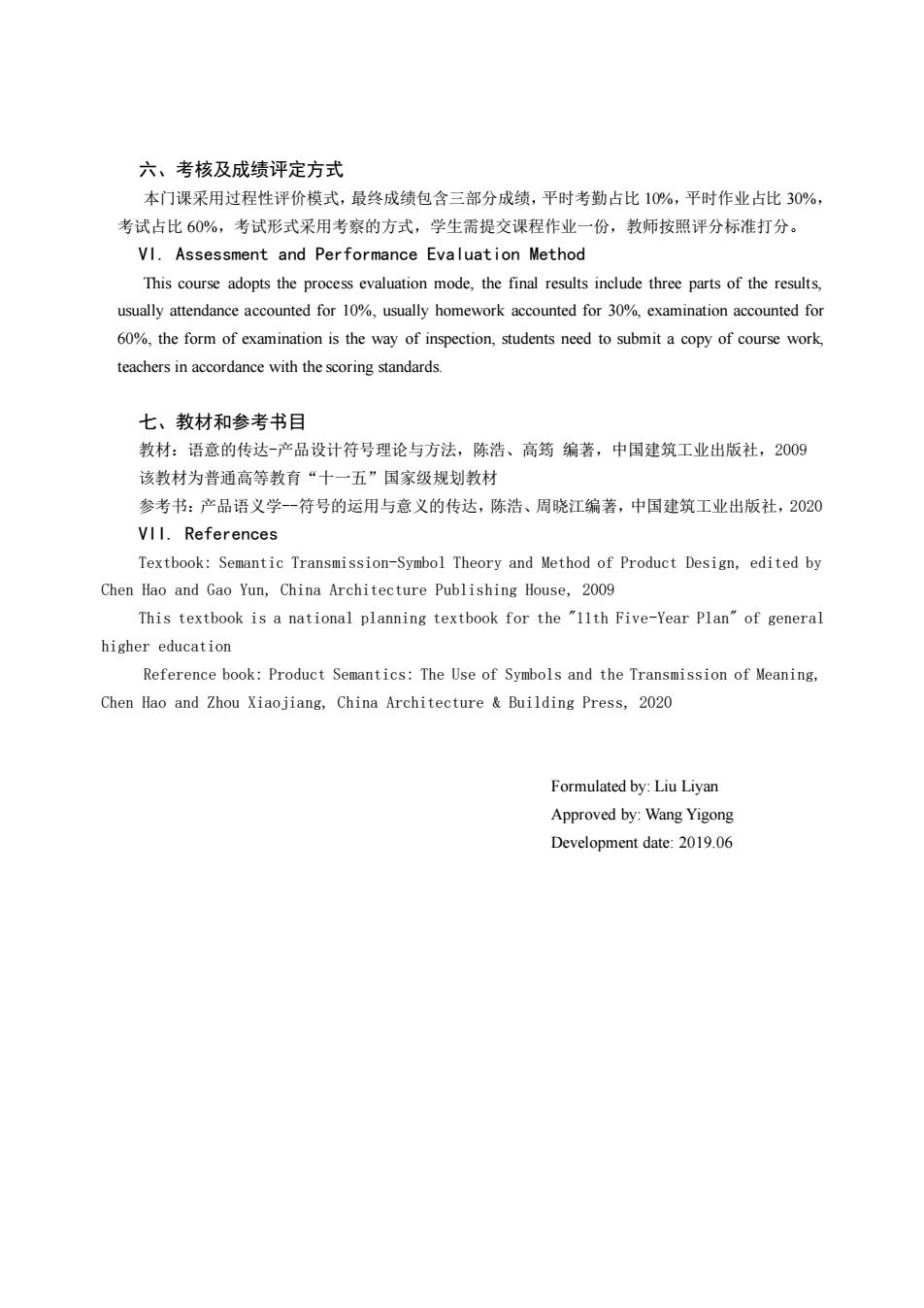
六、考核及成绩评定方式 本门课采用过程性评价模式,最终成绩包含三部分成绩,平时考勤占比10%,平时作业占比30%, 考试占比60%,考试形式采用考察的方式,学生需提交课程作业一份,教师按照评分标准打分。 VI.Assessment and Performance Evaluation Method This cou adopts the proce evaluation mode the final results include three parts of the results usually attendance accounted for 10%.usually homework accounted for 30%.examination accounted for 60%the form of examination is the way of inspection,students need to submit a copy of o work teachers in accordance with the scoring standards. 七、教材和参考书目 教材:语意的传达-产品设计符号理论与方法,陈浩、高筠编著,中国建筑工业出版社,20O9 该教材为普通高等教有“十一五”国家级规划教材 参考书:产品语义学一符号的运用与意义的传达,陈浩、周晓江编著,中国建筑工业出版社,202 VII.References Textbook:Semantic Transmission-Symbol Theory and Method of Product Design,edited by Chen Hao and Gao Yun,China Architecture Publishing House,2009 This textbook is a national planning textbook for the"11th Five-Year Plan"of general higher education Reference book:Product Semantics:The Use of Symbols and the Transmission of Meaning, Chen Hao and Zhou Xiaojiang.China Architecture Building Press,2020 Formulated by:Liu Liyan Approved by:Wang Yigong Development date:2019.06
六、考核及成绩评定方式 本门课采用过程性评价模式,最终成绩包含三部分成绩,平时考勤占比 10%,平时作业占比 30%, 考试占比 60%,考试形式采用考察的方式,学生需提交课程作业一份,教师按照评分标准打分。 VI. Assessment and Performance Evaluation Method This course adopts the process evaluation mode, the final results include three parts of the results, usually attendance accounted for 10%, usually homework accounted for 30%, examination accounted for 60%, the form of examination is the way of inspection, students need to submit a copy of course work, teachers in accordance with the scoring standards. 七、教材和参考书目 教材:语意的传达-产品设计符号理论与方法,陈浩、高筠 编著,中国建筑工业出版社,2009 该教材为普通高等教育“十一五”国家级规划教材 参考书:产品语义学--符号的运用与意义的传达,陈浩、周晓江编著,中国建筑工业出版社,2020 VII. References Textbook: Semantic Transmission-Symbol Theory and Method of Product Design, edited by Chen Hao and Gao Yun, China Architecture Publishing House, 2009 This textbook is a national planning textbook for the "11th Five-Year Plan" of general higher education Reference book: Product Semantics: The Use of Symbols and the Transmission of Meaning, Chen Hao and Zhou Xiaojiang, China Architecture & Building Press, 2020 Formulated by: Liu Liyan Approved by: Wang Yigong Development date: 2019.06